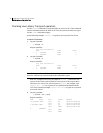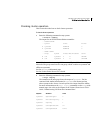
26 Installing and configuring the product
Verifying the configuration files
Checking Low Latency Transport operation
Use the lltstat command to verify that links are active for LLT. This command
returns information about the links for LLT for the system on which it is typed.
See the
lltstat(1M) manual page.
In the following example,
lltstat -n is typed on each system in the cluster.
To check LLT operation
1 Log into system01.
# lltstat -n
Output resembles:
LLT node information:
Node State Links
* 0 system01 OPEN 2
1 system02 OPEN 2
2 Log into system02.
# lltstat -n
Output resembles:
LLT node information:
Node State Links
0 system01 OPEN 2
* 1 system02 OPEN 2
Note: Each system has two links and that each system is in the OPEN state. An
asterisk (*) denotes the system on which the command is typed.
With LLT configured correctly, the output of
lltstat -n shows all of the
systems in the cluster and two links for each system. If the output shows
otherwise, you can use the verbose option of
lltstat. For example, type
lltstat -nvv | more on a system to view additional information about
LLT. In the following example,
lltstat -nvv | more is typed on a system in
a two-node cluster.
3 Log into system01.
# lltstat -nvv | more
Output resembles:
Node State Link Status Address
*0 system01 OPEN lan1 UP 08:00:20:93:0E:34
lan2 UP 08:00:20:93:0E:34
1 system02 OPEN lan1 UP 08:00:20:8F:D1:F2
lan2 DOWN 08:00:20:8F:D1:F2
2 CONNWAIT
lan1 DOWN
lan2 DOWN


















